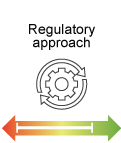| 2021–22 key activities: | |
|---|---|
| 1.1 | Work with government to implement the response to the Senate Standing Committee on Rural and Regional Affairs and Transport report from the inquiry ‘Performance of the Australian Maritime Safety Authority’ |
| 1.2 | Continue to refine AMSA’s Annual Compliance program to focus on high risk operations and targeted education and inspection campaigns, based on a robust analysis of data and other information |
| 1.3 | Complete and evaluate a new port State control targeting system and identify next steps (CAP) |
| 1.4 | Deliver and implement the new Marine Order 505– Certificates of competency – national law. |
| 1.5 | Implement short and long-term approaches for Engine International Air Pollution Prevention (EIAPP) certificate requirements for domestic commercial vessels |
| 1.6 | Explore a phased approach to ending high risk grandfathering arrangements for domestic commercial vessels |
| 1.7 | Embed AMSA’s regulatory and operational risk framework into regulatory and operational business functions |
| 1.8 | Engage with industry on targeted approach to mandating lifejacket wear requirements for domestic commercial vessels in certain high-risk situations |
| 1.9 | Develop an organisational data strategy to strengthen our use of data in decision making and improve our information quality and management |
| 1.10 | Contribute to the whole of government efforts to decommission the Northern Endeavour floating production, storage and offtake (FPSO) facility |
| 2022–25 key activities: | |
|---|---|
| 1.11 | Strengthen key compliance partnerships with other government entities to increase impact and reach |
| 1.12 | Review and implement changes to standards for safety equipment in the National Standard for Commercial Vessels (NSCV subsection C7A) |
| 1.13 | Deliver effective cost determination of regulatory activities and financial reporting of actual costs – automated and predictive analytics using Activity Based Costing methodology |
| 1.14 | Develop a levy revenue portal, measurement and analytics capability (CAP) |
| 1.15 | Work with Government departments and agencies to develop framework for increased oversight of handoff for offshore oil and gas vessels/facilities transitioning between Offshore Petroleum and Greenhouse Gas Storage Act 2009 and Navigation Act 2012 regimes |
| 1.16 | Work with the Government to seek consideration of a package of minor technical and workability amendments to principal legislation to improve the operation of the law, specifically the National Law Act 2012, the Navigation Act 2012 and the Protection of the Sea (Prevention of Pollution from Ships) Act 1983 |
| Primary Enterprise Risk | Moderate Risk Rating | Key mitigation strategies |
|---|---|---|
| (1) AMSA is an ineffective regulator | Risk Appetite & Tolerance  | AMSA has a regulatory plan, policies and an annual compliance program. Risk tolerance statement: We have low tolerance for regulatory approaches that are inconsistent with our mandated obligations under the AMSA Act 1990. We have low to moderate tolerance for risk in the pursuit of innovative regulatory approaches, for example alternative means of compliance—consistent with our Act and Statement of Regulatory Approach 2018. In very specific instances, we have moderate to high tolerance for the application of contemporary and potentially ground-breaking regulatory approaches (including research) that allow us to respond dynamically to changes in our operating environment.1 |
1 The overall risk rating is a combination of likelihood and consequence – see the risk matrix at the end of Strategic objective 9: Organisational capability and resilience.